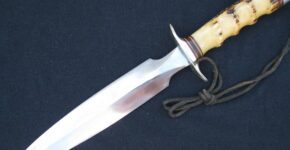

Originally published in the RKS Newsletter #82 May 2009
Fellow collector and longtime Randall knife enthusiast Chuck Shipman sent me some photos of an interesting Model 1-6 he picked up not too long ago. The knife itself was a nice model 1 in standard configuration and in very good condition, but the sheath was the kicker. Several conversations ensued and Chuck sent the knife to me for examination with the possibility of an article for the RKS newsletter
The knife/sheath combo dates from around 1955 based on the grind,spacer configuration, longer lower quillion on the guard (being a bit of a holdover from a couple years earlier), and an early stone in the stone pouch. The five medium thick spacer arrangement that was originally seen in the 40’s showed back up again probably late 1954, but didn’t last long and was all but gone by 1956 as three thick two thin again became the standard of the day.
The only real sign that something is amiss when viewed from the front is the lack of the typical Heiser “back stitch” at the throat. Then, upon closer examination there are what appear to be one pin head at either side of the throat. If you were just to glance at this piece in a case you probably wouldn’t notice them, and might not upon looking closer. So, after noticing what appear to be pin heads, the natural inclination is to examine the rear of the sheath to see exactly what we are looking at. This is where it gets interesting.
The pin heads are actually small brad nails. When they were put in or if they are original to the sheath are unknown. It appears they would be original as there is no evidence of deterioration or weakening of throat of the sheath to warrant adding them later presumably as an effort to reinforce the throat area. My guess is the possibility they were installed at the time of assembly to keep the parts of the sheath aligned while being sewn.
The striking difference between this and other period sheaths is the use of three rivets to attach the belt loop to the rear of the sheath. The top two rivets are visible for examination from the front side of the sheath and are sans any markings that would identify the maker.
I am not sure who made this sheath. It is possible it is a Heiser “experiment”, but it is certainly plausible it was locally made in Orlando. A 6” model 1 is not a very popular model relative to numbers ordered, so it could be Bo was out of 6” model 1 sheaths at the time this order came through. It is also possible this sheath is an example of an early foray by Bo into the use of local sheath makers exclusive of Clarence Moore.
